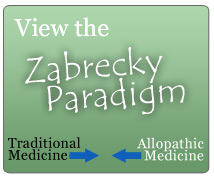Integrative Medicine
According to the National Center for Complementary and Alternative Medicine (part of the NIH):
![]()
- Complementary and Alternative Medicine ("CAM") is a group of diverse medical and health care systems, practices and products that are not generally considered to be part of conventional medicine.
- Complementary Medicine is used together with conventional medicine. An example of a complementary therapy is using to help lessen a patient's discomfort following surgery.
- Alternative Medicine is used in place of conventional medicine. An example of an alternative therapy is using a special diet to treat cancer instead of undergoing surgery, radiation or chemotherapy recommended by a conventional doctor.
- Integrative Medicine combines treatments from conventional medicine and CAM for which there is evidence of safety and effectiveness.
The Consortium of Academic Health Centers defines Integrative Medicine as "the practice of medicine that reaffirms the importance of the relationship between practitioner and patient, focuses on the whole person, is informed by evidence and makes use of all appropriate therapeutic approaches, healthcare professionals and disciplines to achieve optimal health and healing".
What are the major types of complementary and alternative medicine?
NCCAM groups CAM practices into four domains, recognizing there can be some overlap. In addition, NCCAM studies CAM whole medical systems, which cut across all domains.
Whole Medical Systems
Whole medical systems are built upon complete systems of theory and practice. Often, these systems have evolved apart from and earlier than the conventional medical approach used in the United States. Examples of whole medical systems that have developed in Western cultures include homeopathic medicine [A whole medical system that originated in Europe. Homeopathy seeks to stimulate the body's ability to heal itself by giving very small doses of highly diluted substances that in larger doses would produce illness or symptoms (an approach called "like cures like")] and naturopathic medicine [A whole medical system that originated in Europe. Naturopathy aims to support the body's ability to heal itself through the use of dietary and lifestyle changes together with CAM therapies such as herbs, massage, and joint manipulation.]. Examples of systems that have developed in non-Western cultures include traditional Chinese medicine [A whole medical system that originated in China. It is based on the concept that disease results from disruption in the flow of qi and imbalance in the forces of yin and yang. Practices such as herbs, meditation, massage, and acupuncture seek to aid healing by restoring the yin-yang balance and the flow of qi.] and Ayurveda [A whole medical system that originated in India. It aims to integrate the body, mind, and spirit to prevent and treat disease. Therapies used include herbs, massage, and yoga.].
Mind-Body Medicine
Mind-body medicine uses a variety of techniques designed to enhance the mind's capacity to affect bodily function and symptoms. Some techniques that were considered CAM in the past have become mainstream (for example, patient support groups and cognitive-behavioral therapy). Other mind-body techniques are still considered CAM, including meditation [A conscious mental process using certain techniques—such as focusing attention or maintaining a specific posture - to suspend the stream of thoughts and relax the body and mind.], prayer, mental healing, and therapies that use creative outlets such as art, music, or dance.
Biologically Based Practices
Biologically based practices in CAM use substances found in nature, such as herbs, foods, and vitamins. Some examples include dietary supplements, herbal products, and the use of other so-called natural but as yet scientifically unproven therapies (for example, using shark cartilage to treat cancer).
Manipulative and Body-Based Practices
Manipulative and body-based practices in CAM are based on manipulation [The application of controlled force to a joint, moving it beyond the normal range of motion in an effort to aid in restoring health. Manipulation may be performed as a part of other therapies or whole medical systems, including chiropractic medicine, massage, and naturopathy.] and/or movement of one or more parts of the body. Some examples include chiropractic or osteopathic manipulation [A type of manipulation practiced by osteopathic physicians. It is combined with physical therapy and instruction in proper posture.], and massage [Pressing, rubbing, and moving muscles and other soft tissues of the body, primarily by using the hands and fingers. The aim is to increase the flow of blood and oxygen to the massaged area.].
Energy Medicine
Energy therapies involve the use of energy fields. They are of two types:
- Biofield therapies are intended to affect energy fields that purportedly surround and penetrate the human body. The existence of such fields has not yet been scientifically proven. Some forms of energy therapy manipulate biofields by applying pressure and/or manipulating the body by placing the hands in, or through, these fields. Examples include qi gong [A component of traditional Chinese medicine that combines movement, meditation, and controlled breathing. The intent is to improve blood flow and the flow of qi.], Reiki [A therapy in which practitioners seek to transmit a universal energy to a person, either from a distance or by placing their hands on or near that person. The intent is to heal the spirit and thus the body.], and Therapeutic Touch [A therapy in which practitioners pass their hands over another person's body with the intent to use their own perceived healing energy to identify energy imbalances and promote health.].
- Bioelectromagnetic-based therapies involve the unconventional use of electromagnetic fields, such as pulsed fields, magnetic fields, or alternating-current or direct-current fields.







